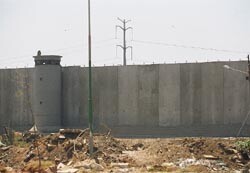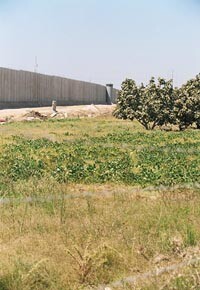East Jerusalem 1 October 2002

Qalqilya Wall (Photo: S.Brannon)
In 1948, 80% of its residents were re-located from surrounding agricultural villages after Israel confiscated their land, olive trees and homes. In 1965, it was invaded for the third time, and the water, piping, and service station were destroyed. In 1996, 300 dunums were confiscated on the west side of the town to create a “main road for Israeli security.” In 1997, to expand a new Israeli military base road, Israel took another 100 dunums. In 2002 June, Israel created a “buffer zone” for military purposes on the south side of the town, and would shoot at any farmers who wanted to harvest their crop in the agricultural area. In August 2002, Israel confiscated 125 dunums that will isolate 2,000 dunums of Qalqilya’s agricultural land.
Israel is currently building an eight-meter (25-foot) high concrete wall, complete with lookout towers located every fifty meters along its length. The wall reminds me of photographs I saw when I was a child learning about the concentration camps for the Jews in Germany. Those photographs were in black and white; this time they are in color. Israel’s apparent plan is to continue building the wall, and in the process, cutting through fields and digging trenches around the city while razor wire will crown the top of the wall.
Just 2 meters from the wall is a new elementary school. A lookout tower commands the area while children play outside. Random shots ring out whenever a child gets too close to the wall.
Mayor Maron Zaron says, “We can’t have the school here, it is not safe for the children. When we built the school, we didn’t know they were going to take more of the area.”
Three families have already been issued home demolition orders, rendering the occupants homeless. They will not be compensated for the demolition of their homes or the loss of their land.

Qalqilya Wall (Photo S. Brannon)
“Too many Palestinians and too few of us. There is no way we can cope with the number of cars here. The only solution is to cause long queues in both directions. Obediently, people line up. They wait their turn to enter or exit their own city. Some people are held up several hours per day. The people of Qalqilya have learnt that the best defense is steadfastness.“It is Ramadan and people are tired and hungry. One unshaven fellow looks longingly at my cigarette. Feeling guilty, I stomp it out. As a soldier, I may occupy his country, encircle his village, and destroy his vineyards. But I know what nicotine craving is like.”
It is not that the Israelis are ignorant of the situation, many soldiers say, “I do what I have to do. I try to be nice, hoping that it makes things as easy as possible for all of us.”
Yet ironically, the Israeli government continues to use the Palestinian population as pawns in order to secure its goals and realize its long-term plans. What are the final goals and plans? One cannot be quite sure, but water may be more at issue than security.
Recently, Israel approached the city council of Qalqilya, presenting a map asking for permission to build an eight-meter wall closing off the agricultural land in the southern end of the town. This move will take an additional 2,000 dunums of agricultural land from people. The government of Israel assured the council that the farmers would be able to continue to maintain and harvest their land as long as they had permits allowing them to enter and exit a newly constructed ‘gate’ that comprises their only access to and from the town.
Mayer, Maron Zaron recalls that the same type of situation occurred in 1949: “We received the same promises and were approached for permission to bring people in from 28 surrounding villages. When they did this, they took the land.” His frustrated voice rang inside of the council room tinged with a feeling of betrayal and loss.
“We know that they will build the new wall anyway, and will not issue permits for our farmers. What are we to do? They will do what they want anyway. At this time, we cannot even water our trees or produce for the fear of being shot. How do they expect us to believe that we can harvest our own land?”
The map shows how the intended wall will dissect Qalqilya into a cramped housing area without any room for future expansion, turning it into a refugee camp or an open-air prison. “The wall will confiscate 3 of our wells and cisterns and thus deprive our olive trees of the proper irrigation.”
Is this wall meant to attain water or security? Qalqilya has one of the region’s largest aquifers, and thus the potential to develop the region into a lush fertile valley. Israel does not allow the Palestinians free access to the water. Meanwhile, they, in turn, have sunk eight wells at various points around Qalqilya which pump out 77,000 cubic feet of water per hour. Nine Israeli settlements are scattered around the town, consuming additional water resources.
The settlements give Israel an excuse to build this security wall that will trap and isolate over 11,000 people. This eight-meter, razor-wired wall will further deprive Qalqilya’s residents from their basic needs to work, to receive proper medical care, and to harvest their own land.
Susan Brannon is a freelance photojournalist who “can’t keep quiet” and has expanded her portfolio into article writing “for the education of others regarding the situation in Palestine.” She write news updates for the Media Monitors Network and works in archaeology at the Albright Institute in Jerusalem.
Related Links:

